The following letters are selected from the Smithsonian’s Archives of American Art and included in the collection Pen to Paper. Each reveals how letter writing can be an artistic act and offers a personal glimpse into the daily life of a revered artist.
Berenice Abbott
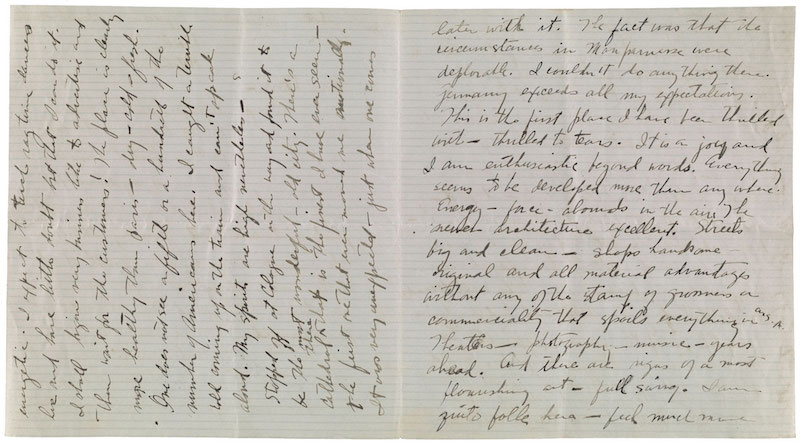
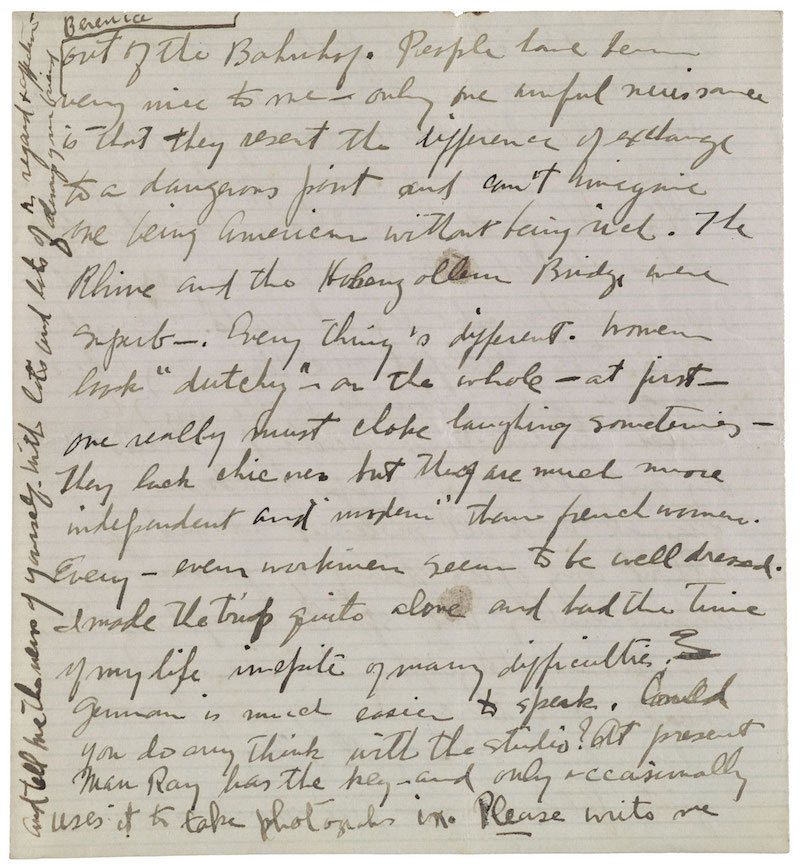 Berenice Abbott c/o American Express— 55 Charlottenstrasse
Berlin
Octobre 16—
Berenice Abbott c/o American Express— 55 Charlottenstrasse
Berlin
Octobre 16—
Dear Storrs— Always surprises. The last time I write you a letter of despair—the next you find me in Berlin. But it was very sudden—my good luck—my desire—for quite a while. I had one day a sudden flash of intuition about Germany. It came like an inspiration. I was in terrible straits at the time— thought I might sell my studio but found that it could not be exchanged. Someone, however loned me enuf to get to Berlin and rather than simply loose the studio I payed the up to January. Something may be done later with it. The fact was that the circumstances in Monparnasse were deplorable. I couldn’t do anything there. Germany exceeds all my expectations. This is the first place I have been thrilled with—thrilled to tears. It is a joy and I am enthusiastic beyond words. Everything seems to be developed more than any where. Energy—force—abounds in the air. The newer architecture excellent. Streets big and clean—shops handsome—original and all material advantages without any of the stamp of grossness or commerciality that spoils everything in U.S.A. Theaters—photography—music—years ahead. And there are signs of a most flourishing art—full swing. I am quite folle here—feel much more energetic. I expect to teach rag time dances here and have little doubt but that I can do it. I shall begin very business like to advertise and then wait for the customers! The place is clearly more healthy than Paris—dry—cold—fresh. One does not see a fifth or a hundredth of the number of Americans here. I caught a terrible cold coming up on the train and can’t speak aloud. My spirits are high nevertheless—Stopped off at Cologne on the way and found it to be the most wonderful— old city. There’s a cathedral there that is the nest I have ever seen—the first one that ever moved me emotionally. It was very unexpected—just when one comes out of the Bahnhof. People have been very nice to me—only one awful nuisance is that they resent the difference of exchange to a dangerous pint and can’t imagine one being American without being rich. The Rhine and the Hohenzollern Bridge were superb—. Everything’s different. Women look “dutchy”—on the whole— at first—one really must choke laughing sometimes—They lack chicness but they are much more independent and “modern” than french women. Every—even workmen seem to be well dressed. I made the trip quite alone and had the time of my life in spite of many difficulties. German is much easier to speak. Could you do any think with the studio? At present Man Ray has the key—and only occasionally uses it to take photographs in. Please write me and tell me the news of yourself. With lots and lots of regard & affection —always your friend Berenice
Letter to John Henry Bradley Storrs, October 16, 1921 4 pp.; 19 × 18 cm; John Henry Bradley Storrs papers Courtesy of The Estate of Berenice Abbott
Mary Cassatt
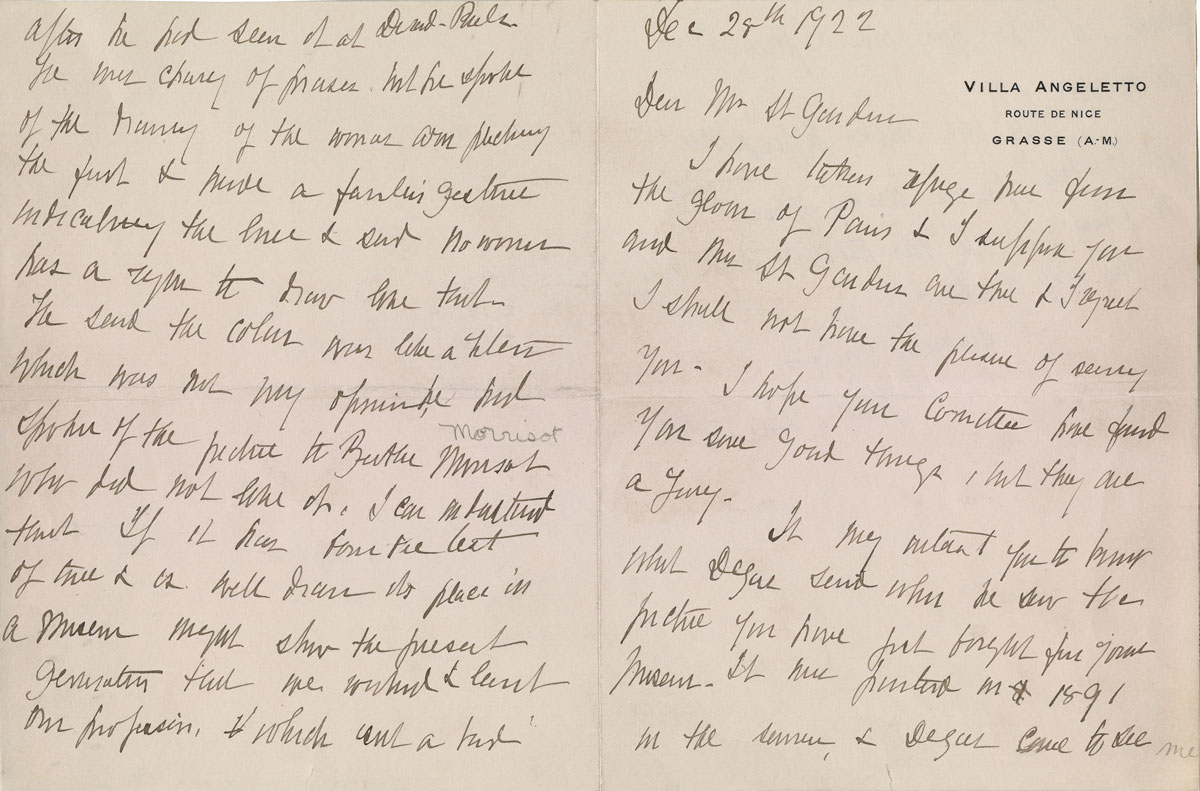
Dec 28th 1922
Dear Mr St Gaudens
I have taken refuge here from the gloom of Paris & I suppose you and Mrs St Gaudens are there & I regret I shall not have the pleasure of seeing you. I hope your Committee have found you some good things, but they are a Jury.
It may interest you to know what Degas said when he saw the picture you have just bought for your Museum. It was painted in & 1891 in the summer, & Degas came to see me after he had seen it at Durand-Ruels. He was chary of praise, but he spoke of the drawing of the woman arm plucking the fruit & made a familiar gesture indicating the line & said no woman has a right to draw like that. He said the color was like a Whistler which was not my opinion, he had spoken of the picture to Berthe Morisot who did not like it. I can understand that. If it has stood the test of time & is well drawn its place in a Museum might show the present generation that we worked & learnt our profession, & which isnt a bad thing—I hope you had a pleasant time in Rome.
My best wishes to you & Mrs St Gaudens for the coming year may it bring you all this troubled world can give of good.
Sincerely yours Mary Cassatt
[Durand-Ruels is the gallery of Paul Durand-Ruel (1831–1922), a French art dealer who represented many Impressionist painters.]
letter to Homer Saint-Gaudens, December 28, 1922 3 pp.; 19 × 14 cm; Carnegie Institute, Museum of Art records
Mary Cassatt
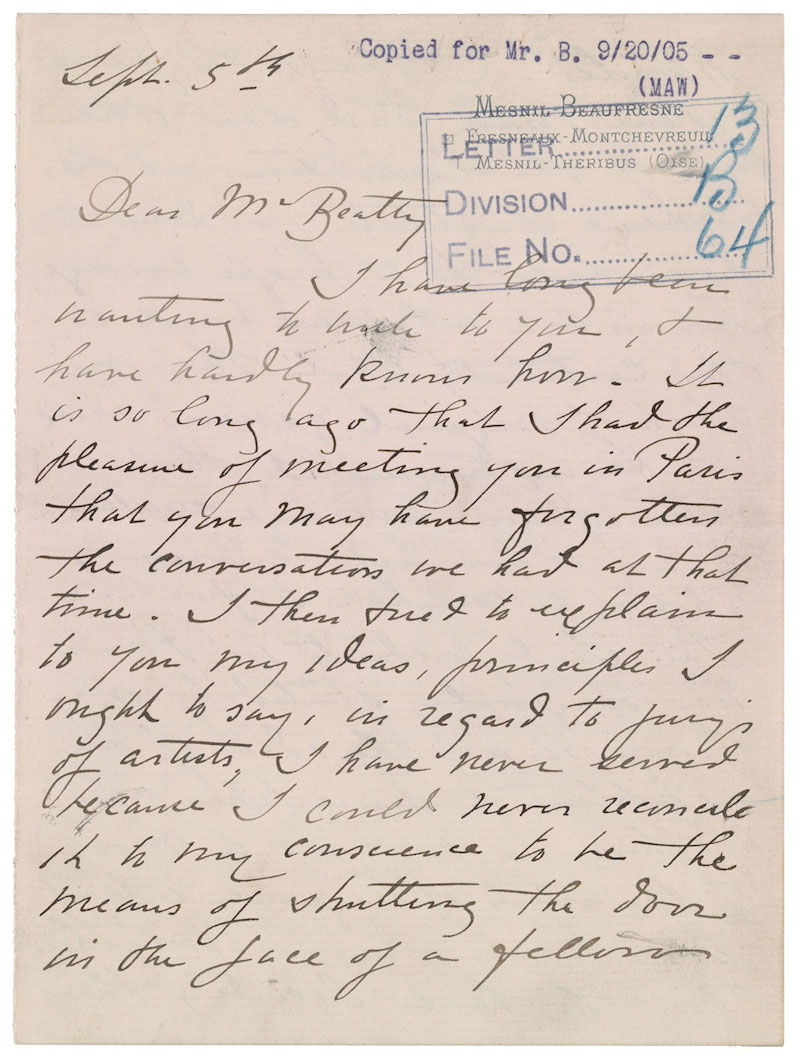
Sept. 5th
Dear Mr. Beatty
I have long been wanting to write to you, & have hardly known how. It is so long ago that I had the pleasure of meeting you in Paris that you may have forgotten the conversations we had at that time. I then tried to explain to you my ideas, principles I ought to say, in regard to jury’s of artists, I have never served because I could never reconcile it to my conscience to be the means of shutting the door in the face of a fellow painter. I think the jury system may lead, & in the case of the Exhibitions at the Carnegie Institute no doubt does lead to a high average, but in art which we want is the certainty that the one spark of original genius shall not be extinguished, that is better than average excellence, that is what will survive, what it is essential to foster—‘The ‘Indepéndents” in Paris was originally started by our Group, it was the idea of our exhibitions & since taken up by others, no jury’s & most of the artists of original talent have made their debut there in the last decade, they would never have had a chance in the official Salons. Ours is an enslaved profession, fancy a writer not being able to have an article published unless passed by a jury of authors, not to say rivals—
Pardon this long explanation, but the subject excites me, it seems to me a very serious question in our profession, these are my reasons for never having served on the jury of the Institute, if I could be of the least service in any other way I would most gladly. I would consider nothing a trouble to serve the Institute of which you are so devoted a Director. As to sending pictures, this year I have none, they have been sold in Paris and I could not ask the owners to send them so far as it would seem to them.
With my sincere regrets and my renewed excuses, believe me, my dear Mr. Beatty
Most sincerely yours Mary Cassatt
letter to John Wesley Beatty, September 5, 1905 4 pp.; 18 × 27 cm; Carnegie Institute, Museum of Art records
Joseph Cornell
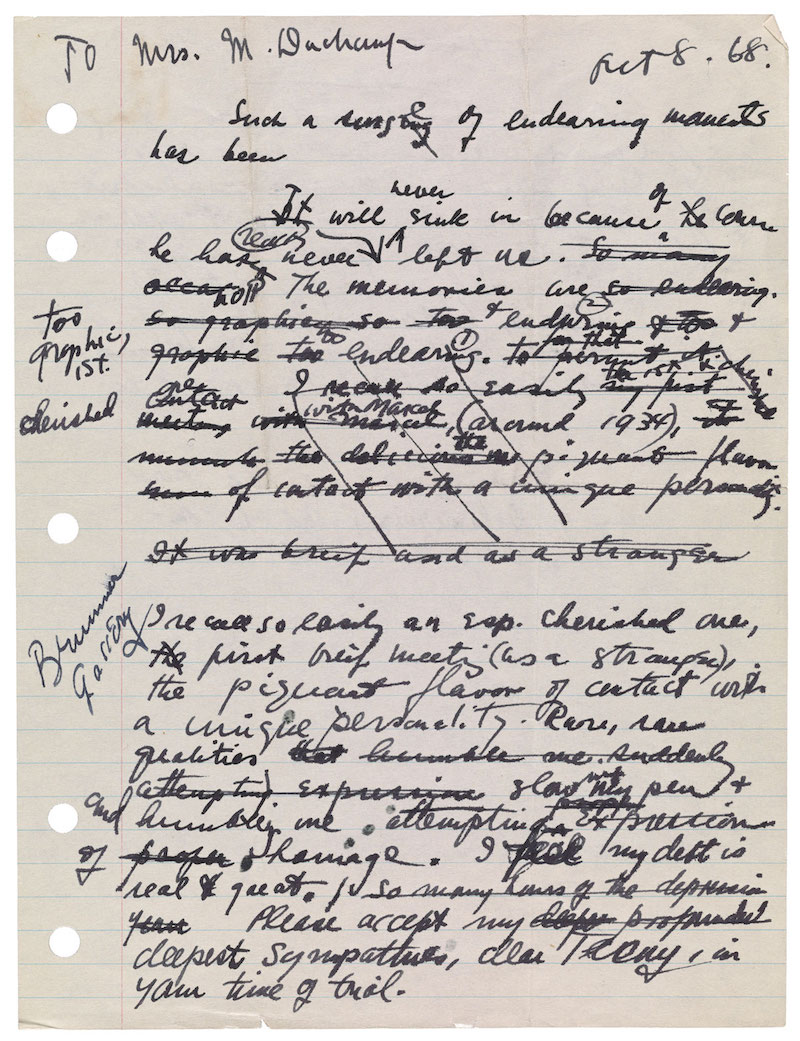
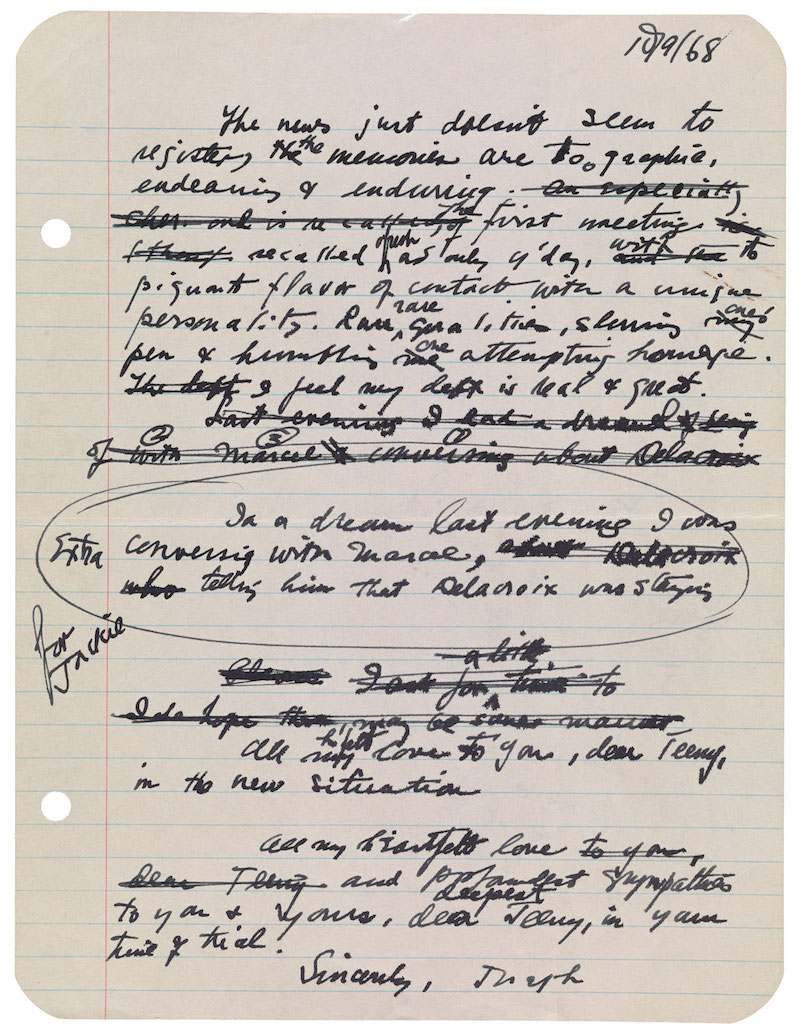
To Mrs. M. Duchamp Oct 8. 68.
Such a surging[insertion: e] of endearing moments has been
It will [insertion: never] sink in because [insertion: of] he course he has never [insertion: really] left us. So many accept No ¶ The memories are so endearing. So graphic, so too & enduring & too & graphic too [insertion: too graphic] + too endearing. 1 [circled]. permit its cherished contact. I recall so easily my first meeting with Marcel, (around 1934), the moments the delicious the piquant flavor [illegible] of contact with a unique personality.
It was brief and as a stranger
Brummer Gallery
I recall so easily an esp. cherished one, the first brief meeting (as a stranger), the piquant flavor of contact with a unique personality. Rare, rare qualities that humble one. Suddenly attempting expression slowing my pen & and humbling me attempting Expression of proper homage. I feel my debt is real & great. so many hours of the depression years Please accept my deepest profoundest deepest sympathies, dear Teeny, in your time of trial.
10/9/68
The news just doesn’t seem to register the the memories are too graphic, endearing & enduring. An especially cher. one is recalled of the first meeting is thought recalled [insertion: fresh] as only y’day, and the with its piquant flavor of contact with a unique personality. Rare [insertion: rare] qualities, shaming my one’s pen & humbling me one attempting homage. The debt I feel my debt is real & great.
Last evening I had a dream of being of with Marcel & conversing about Delacroix
Extra
In a dream last evening I was conversing with Marcel, about Delacroix who telling him that Delacroix was staying. [sentence is circled]
for Jackie
Please I ask for ˄a little time to to
I do hope there may be some moment
All my [insertion: h felt] love to you, dear Teeny, in this new situation.
All my heartfelt love to you, dear Teeny and profoundest [insertion: deepest] sympathies to you & yours, dear Teeny, in your time of trial.
Sincerely, Joseph
drafts of a letter to Teeny Duchamp, October 8 and 9, 1968 4 pp.; 27 × 20 cm; Joseph Cornell papers
Willem de Kooning
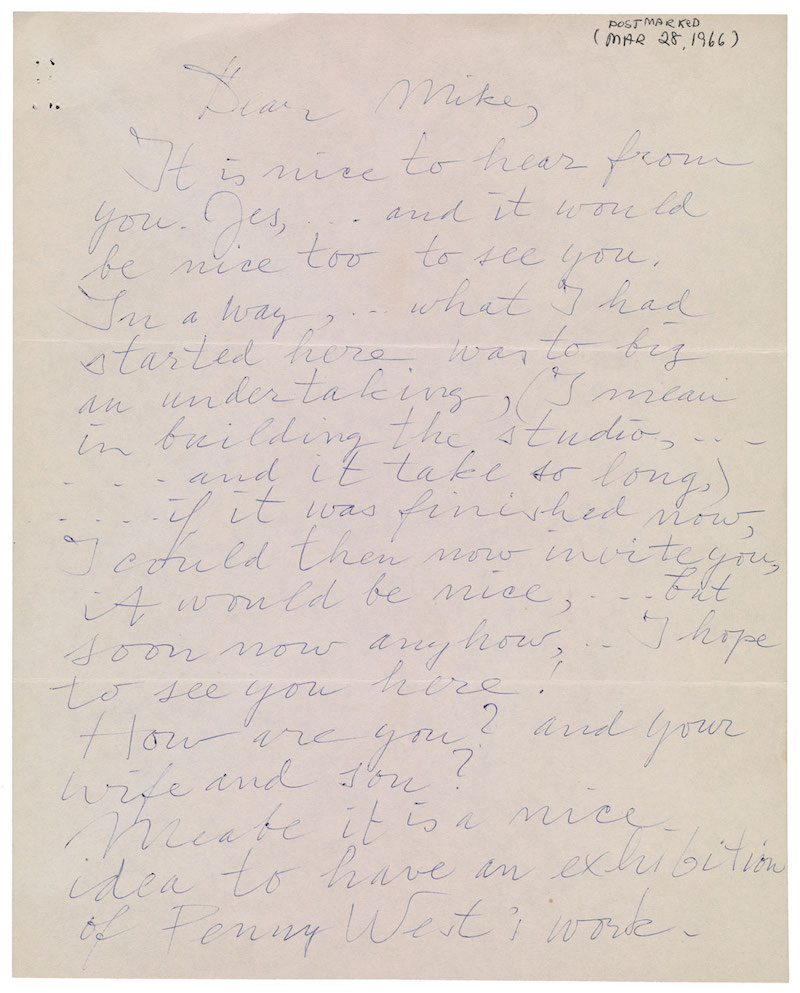
Dear Mike,
It is nice to hear from you. Yes,…and it would be nice too to see you. In a way,…what I had started here was to big an undertaking, (I mean in building the studio,……and it take so long,)…. if it was finished now, I could then now invite you, it would be nice,…but soon now anyhow,..I hope to see you here!
How are you? and you wife and son?
Meabe it is a nice idea to have an exhibition of Penny West’s work.
So many of our friends are gone. Add my name,. Yes! Your son must be growing up? My daughter is 10 years already. Give my love to them, and you too.
Love Bill
letter to Michael Loew, March 28, 1966; 1 p.; 26 × 21 cm; Michael Loew papers. All quotations by Willem de Kooning © 2016 Estate of Lisa de Kooning
Dan Flavin
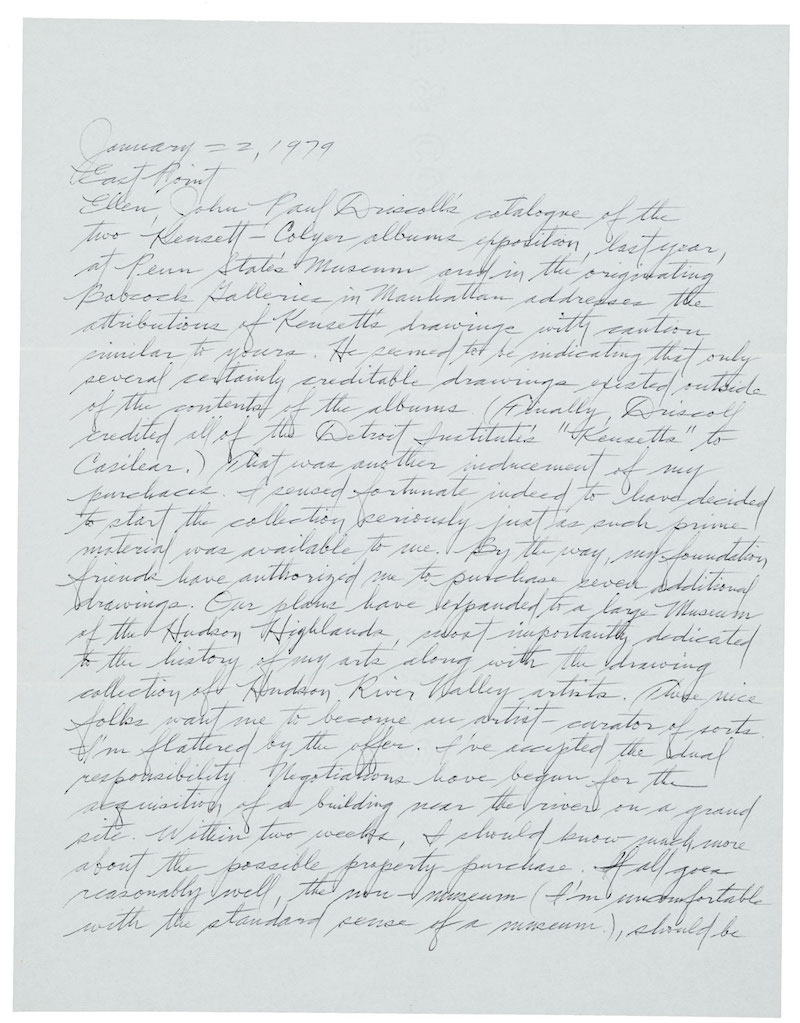
January 22, 1979 East Point
Ellen, John Paul Driscoll’s catalogue of the two Kensett-Colyer albums exposition, last year, at Penn State’s Museum and in the originating Babcock Galleries in Manhattan addresses the attributions of Kensett’s drawings with caution similar to yours. He seemed to be indicating that only several certainly creditable drawings existed outside of the contents of the albums. (Finally, Driscoll credited all of the Detroit Institute’s “Kensetts” to Casilear.) That was another inducement of my purchases. I sensed fortunate indeed to have decided to start the collection seriously just as such prime material was available to me. By the way, my foundation friends have authorized me to purchase seven additional drawings. Our plans have expanded to a large Museum of the Hudson Highlands, most importantly dedicated to the history of my arts along with the drawing collection of Hudson River Valley artists. These nice folks want me to become an artist-curator of sorts. I’m flattered by the offer. I’ve accepted the dual responsibility. Negotiations have begun for the acquisition of a building near the river on a grand site. Within two weeks, I should know much more about the possible property purchase. If all goes reasonably well, the non-museum (I’m uncomfortable with the standard sense of a museum.), should be ready in a few years. And perhaps, you would be so kind as to lend some of your Kensetts to us for our triumphant gala opening. By the way, I found a reference for you about your group of drawings. They are sketches for engraved illustrations for George Curtis’s “Lotus Eating: A Summer Book” of 1852. Driscoll dates those sketches 1851. Here is my combined list of purchases or, soon to be purchased drawings: “Windsor Castle” (184?) (Driscoll catalogue number 7), “Stolzenfels” (August 3, 1845) (no. 11), “The Bay of Baiae (?) with Ischia” (1847) (uncatalogued), “Camel’s Hump beyond Lake Champlain” (August 25, 1848) (no. 39), “The Great Gorge of the Hudson Highlands from Newburgh” (1848–1849) (uncatalogued), “Catskill Mountains” (1848–1849) (no. 42), “Trees, Franconia Notch” (October 20, 1850) (no. 44), “Niagara Trees, Franconia Notch (?)” (1850) (no. 48), “Niagara Falls” (circa 1852) (no. 55), “Rocks and Trees near Niagara Falls” (circa 1852)
( no. 56) and “Rocks and Trees near Niagara Falls (?)” (circa 1852) (no. 56 57). I will look for your book, “Modern Art and the Object” mit footnote- worthies. Thank you. Dan F.
By the way, I’m supposed to reciprocate for Don Judd in his Marfa, Texas buildings complex. I hope that I won’t find “dry gulch”, ’way the hell down there.
letter to Ellen H. Johnson, January 22, 1979 2 pp.; 28 × 22 cm; Ellen Hulda Johnson papers Reproduced with permission of The Dan Flavin Estate
Ray Johnson

EVA—
HELLO
[drawing of a bunny]
RAY
[written in a different hand: Ray Johnson 9.15.69 left under door of gallery]
letter to Eva Lee, September 15, 1969 1 p.; 21 × 13 cm; Eva Lee Gallery records © 2016 Estate of Ray Johnson. Courtesy of Richard L. Feigen & Co.
Lee Krasner
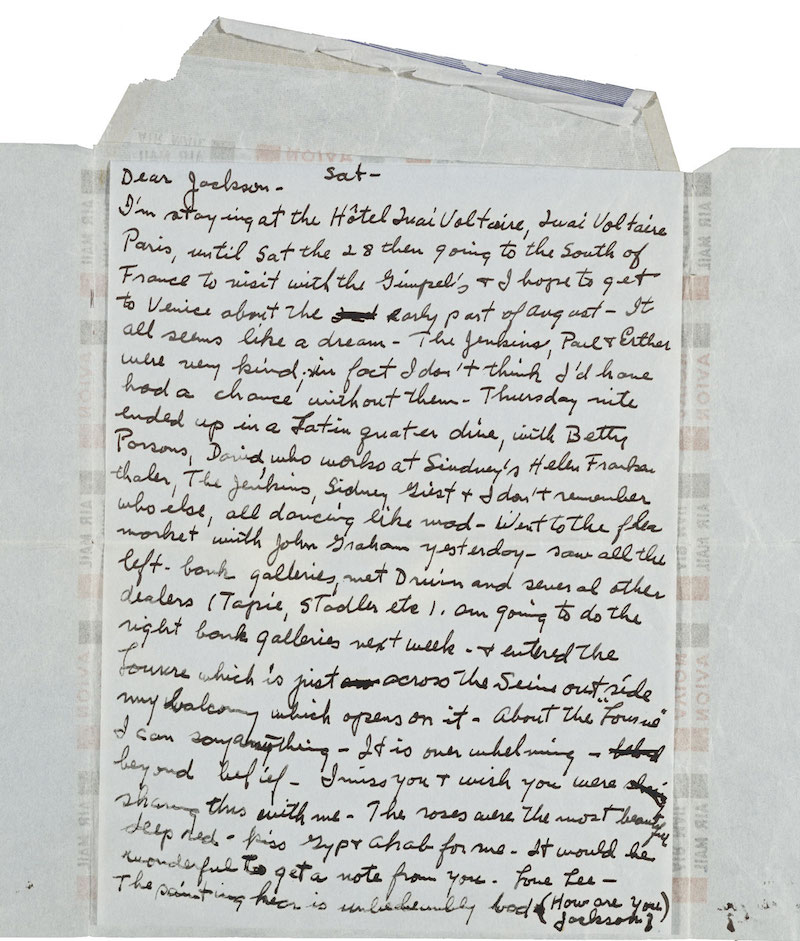
Sat—
Dear Jackson— I’m staying at the Hôtel Quai Voltaire, Quai Voltaire Paris, until Sat the 28 then going to the South of France to visit with the Gimpel’s & I hope to get to Venice about the 2nd early part of August—It all seems like a dream—The Jenkins, Paul & Esther were very kind; in fact I don’t think I’d have had a chance without them. Thursday nite ended up in a Latin quater dive, with Betty Parsons, David, who works at Sindney’s Helen Frankenthaler, The Jenkins, Sidney Giest & I don’t remember who else, all dancing like mad— Went to the flea market with John Graham yesterday—saw all the left-bank galleries, met Druin [Drouin] and several other dealers (Tapie, Stadler etc). I am going to do the right bank galleries next week—& entered the Louvre which is just on across the Seine outside my balcony which opens on it—About the “Louvre” I can say anything—It is over whelming—beyond belief—I miss you & wish you were shari sharing this with me—The roses were the most beautiful deep red—kiss Gyp & Ahab for me—It would be wonderful to get a note from you. Love Lee—
The painting hear is unbelievably bad (How are you Jackson?)
[Krasner stayed with Paul and Esther Jenkins in Paris. Paul (1923–2012) was an Abstract Expressionist; Sidney Geist (1914–2005) was a sculptor and writer; Gyp and Ahab were Pollock and Krasner’s dogs.]
letter to Jackson Pollock, July 21, 1956 1 p.; 24 × 32 cm; Jackson Pollock and Lee Krasner papers
Claes Oldenburg

Marmont Hotel 8221 Sunset 0L6–1010
no typewriter
until Aug 9
1. It is made of odds + ends and only measures about 3”. I had a real drum set when I was about 14 + enjoyed playing it, along with jazz records. I also tried playing piano + guitar but liked the drums best tho I hadnt the patience or whatever to learn it very well. I eventually sold the set.Music was later an inspiration to modern form. I mean I got out of the Wagner hole my Mother favored via Stra-vinsky + Ravel—which wasnt very modern in 1954 but modern to me. Stravinsky whom I then collected had an influence on my attitude and style, expressed in drawing. I also admired his discipline and read his prose and aquired his prejudices fx liking the “out” Tchaikovsky. Ravels detachment while producing emo-tion fascinated me, also his parodies which were still art in the best sense.I was fond of blues way back and all rhythmic music. Walter de Maria who is a good drummer seemed to take my soft Drum sit [insertion: as a] personal attack via magic. He and Pat were seeing each other then and felt a bond a-gainst—the icy monster. All that is rumor. Music means a lot to me + it translates for me into art. We could discuss this.
3. It appears now, due to prohibitive transportation costs and the complex engineering of the Ice Bag, that it will not travel to Osaka but be built here (LA) by Gemini Ltd, in edition [insertion: of five] + perhaps shown at MOMA or during tour of my show. The six foot model here is very promising, it moves too. Size projected is 24 ft diam. and 11 ft high.
letter to Ellen H. Johnson, 1971 6 pp.; 34 × 22 cm; Ellen H. Johnson papers
Cy Twombly
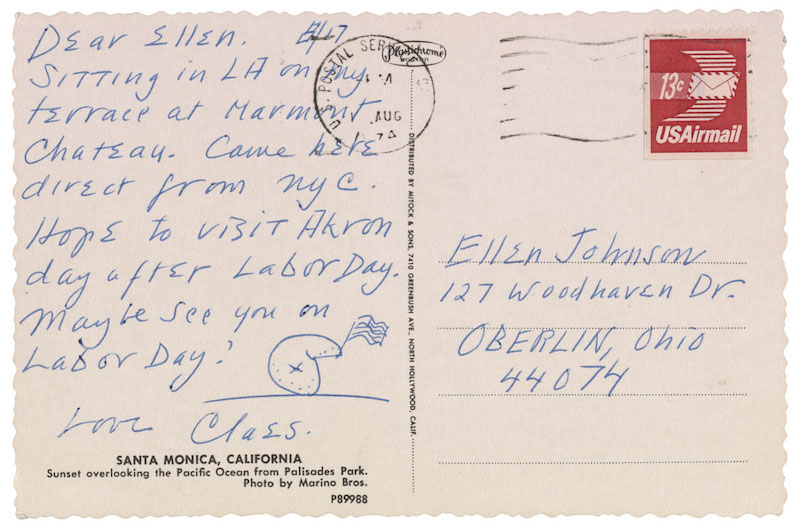
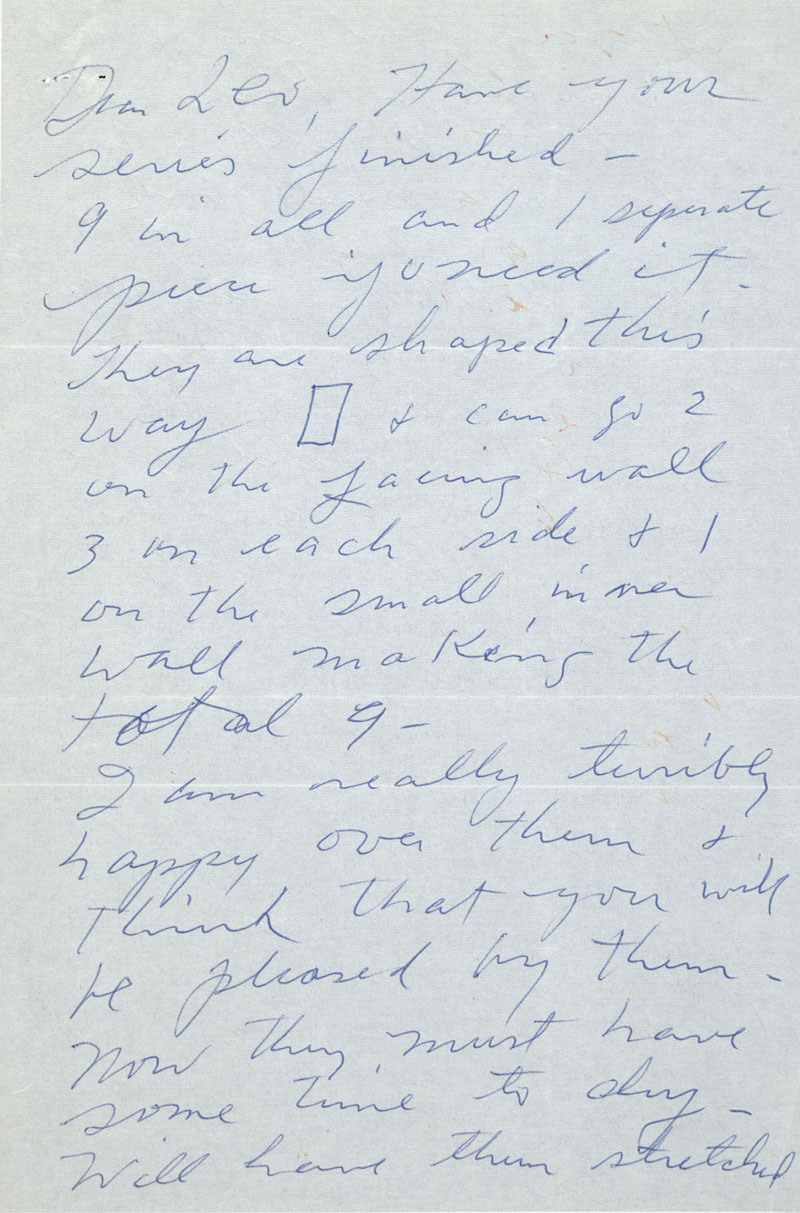
Dear Leo, Have your series finished—9 in all and 1 separate piece if u need it. They are shaped this way [vertical rectangle] + can go 2 on the facing wall 3 on each side + 1 on the small inner wall making the total 9—
I am really terribly happy over them & think that you will be pleased by them—Now they must have some time to dry—will have them stretched but very good dry wood (if possible)—Plinio wants to do all 9 in color for a small book as soon as they are able to be stretched. Any way if you would like to make plans as to the time—Maybe in March as we talked of because they can certainly be sent by the middle of Feb—What else? Did you want drawings and how many do you think of—? Thank you so much for giving the check on the Commodo. I lost my head for it, but it inspired this series so maybe it is good to loose my head, + gain a new—My fond regards to your nice new family—& also thank Ivan for his always kind help.
love—Cy
[Plinio is Italian art dealer and photographer Plinio De Martis (1920–2004); Ivan is Ivan Karp (1926–2012), who was the associate director of the Leo Castelli Gallery at the time of this letter.]
letter to Leo Castelli, ca. 1963 2 pp.; 25 × 16 cm; Leo Castelli Gallery records Reproduced with permission of the Cy Twombly Foundation
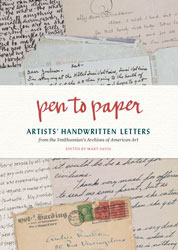 From Pen to Paper Artists’ Handwritten Letters from the Smithsonian’s Archives of American Art. Used with permission of Princeton Architectural Press and the Smithsonian’s Archives of American Art. Copyright 2016 by Mary Savig.
From Pen to Paper Artists’ Handwritten Letters from the Smithsonian’s Archives of American Art. Used with permission of Princeton Architectural Press and the Smithsonian’s Archives of American Art. Copyright 2016 by Mary Savig.
Mary Savig
Mary Savig is curator of manuscripts at the Smithsonian's Archives of American Art.













